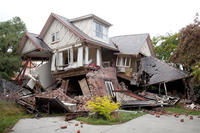-
Earthquake insurer seeks to diversify risk
In an effort to diversify its risk and expand earthquake coverage, the California Earthquake Authority (CEA), an insurance provider, has begun issuing bonds; the company says the initial bond issuance is part of its larger goal to expand the number of homes it covers
-
-
Disasters take toll on PartnerRe’s profits
On Monday PartnerRe Ltd., the international reinsurer, announced that its second quarter earnings fell 35 percent as a result of the devastating natural disasters that struck around the world
-
-
Missouri Governor pledges $25 million for flood relief
On Tuesday, Missouri Governor Jay Nixon pledged $25 million in state aid to help cities and counties rebuild following crippling floods throughout the southern half of the state; it is unclear whether the state will be forced to make budget cuts in order to afford the disaster spending; on Monday President Obama issued a major disaster declaration for five Missouri counties; under the declaration residents of the five counties are eligible to apply for federal assistance for the costs of temporary housing, home repairs, and loans to cover uninsured losses
-
-
World's largest reinsurer posts lower losses than expected

The world’s largest reinsurer, Munich Re, posted smaller than expected losses for the first quarter of this fiscal year; the insurance giant warned investors for a “clearly negative” quarter as a result of insurance claims following the devastating earthquakes in Japan and New Zealand this year; but, its net losses were mitigated in large part by smaller tax bills as a result of the natural disasters; industry analysts expected the reinsurance giant to post a loss of roughly 1.6 billion Euros ($2.28 billion), however the firm defied expectations posting a net loss of 947 million Euros thanks to a favorable tax gain of 612 million Euros due to its quarterly losses
-
-
2010 record year for economic costs from disasters
On Tuesday the Swiss insurance giant Swiss Re, released a study that found disasters in 2010 caused more than three times as much economic damage as 2009; last year disasters caused more than $218 billion in economic losses, the most in over thirty years; in 2010, insured losses totaled $48 billion, an increase of 60 percent from 2009; 2011 is on track to surpass 2010 as the costliest year, with massive earthquakes in Japan and New Zealand; the Japanese government estimates that the 9.0 magnitude earthquake and tsunami caused as much as $309 billion in damages
-
-
Lloyds of London's 2010 profit dropped 43 percent as a result of diasasters
The profits of Lloyd’s of London dropped by 43 percent last year as the insurance market took big losses from earthquakes in Chile and New Zealand and from BP’s oil rig spill in the Gulf of Mexico
-
-
Japan's disaster draws attention to little-known U.S. nuclear insurance plan
A little-known insurance pool in the United States that would provide insurance coverage for victims of nuclear reactor accidents occurring in the United States; the pool has been around for decades; Created under the Price-Anderson Nuclear Industries Indemnity Act of 1957 (Price-Anderson), the pool provides general liability insurance
-
-
New Zealand quake could take ten years and $15 billion to clean up

David Carter, New Zealand’s acting economic development minister, estimates that it could take ten years to rebuild Christchurch after a 6.3 magnitude earthquake rocked the town last month; the cost of rebuilding is estimated at $15 billion and climbing; nearly a third of the buildings in its business district have been declared unsafe; New Zealand prime minister John Key ruled out an earthquake tax for fear it would hurt the economy, which has been hit hard by the recession; New Zealand is actively soliciting international aid to help with its recovery; Christchurch has a population of roughly 377,000 and makes up about 15 percent of the nation’s economy
-
-
2010: a year of costly disasters
Altogether, a total of 950 natural catastrophes were recorded last year, nine-tenths of which were weather-related events like storms and floods; this total makes 2010 the year with the second-highest number of natural catastrophes since 1980, markedly exceeding the annual average for the last ten years (785 events per year); the overall losses amounted to around $130 billion, of which approximately $37 billion was insured; the five “great natural catastrophes” of 2010 — the earthquakes in Haiti (1/12), Chile (2/27), and central China (4/13), the heat wave in Russia (July to September), and the floods in Pakistan (July to September) — claimed approximately 295,000 lives
-
-
Who is the culprit in the Queensland floods: man or nature?
Climate change may contribute to the intensification of natural disasters, but the major drivers of the rapidly rising costs of natural disasters — in Australia and around the world — are societal changes such as increases in population, wealth, and inflation, not climate change; the only way to reduce the scale of future disasters in Australia are risk-informed land planning policies with risks appropriately priced by an active insurance market; in simple terms, for flood and bushfire, this means an end to unmanaged development of flood plains or within bushlands
-
-
U.S.: hundreds of levees no longer safe -- property owners to pay flood insurance
To keep a levee accredited, local governments or other responsible parties must certify that it can handle a flood so severe that it has a 1 percent chance of occurring each year; FEMA has revoked its accreditation of hundreds of levees nationwide, concluding that they no longer meet its standards that ensure protection during major floods, a decision that forces thousands of property owners to buy federal flood insurance
-
-
Cybersecurity insurance gains more adherents
With so many large U.S. companies suffering security breaches — and with companies losing an average of $234,000 per breach in 2009 — more consideration is being given to cybersecurity insurance; a crashed server policy is not as easy to write as a crashed car policy
-
-
Insuring cities against terrorist attacks
Do small towns really need to spend money for terrorism insurance? To collect on such policies, an act of terrorism has to be certified by the U.S. attorney general, the Department of the Treasury and the secretary of state; there also has to be at least $5 million in damage and an intent to coerce or influence U.S. policy; nuclear, biological, chemical, and radiological attacks are excluded
-
-
Demand for stand-alone terrorism coverage down
Reinsurers would like to place more terrorism business, but the demand for stand-alone terrorism coverage is on the wane; the market could tighten if the Obama administration proceeds with its plan to scale back the federal government’s terrorism insurance backstop, which has been in place since 2002
-
-
National insurance for natural disasters: a necessity or "beach house bailout"
Supporters of national disaster insurance program say it is better to plan ahead than do a bailout after a natural disaster; opponents say it would be a subsidy for owners of coastal mansions and encourage people to live in disaster-prone areas
-
- All
- Regional
- Water
- Biometrics
- Borders/Immig
- Business
- Cybersecurity
- Detection
- Disasters
- Government
- Infrastructure
- International
- Public health
- Public Safety
- Communication interoperabillity
- Emergency services
- Emergency medical services
- Fire
- First response
- IEDs
- Law Enforcement
- Law Enforcement Technology
- Military technology
- Nonlethal weapons
- Nuclear weapons
- Personal protection equipment
- Police
- Notification /alert systems
- Situational awareness
- Weapons systems
- Sci-Tech
- Sector Reports
- Surveillance
- Transportation
Advertising & Marketing: advertise@newswirepubs.com
Editorial: editor@newswirepubs.com
General: info@newswirepubs.com
2010-2011 © News Wire Publications, LLC News Wire Publications, LLC
220 Old Country Road | Suite 200 | Mineola | New York | 11501
Permissions and Policies
Editorial: editor@newswirepubs.com
General: info@newswirepubs.com
2010-2011 © News Wire Publications, LLC News Wire Publications, LLC
220 Old Country Road | Suite 200 | Mineola | New York | 11501
Permissions and Policies
